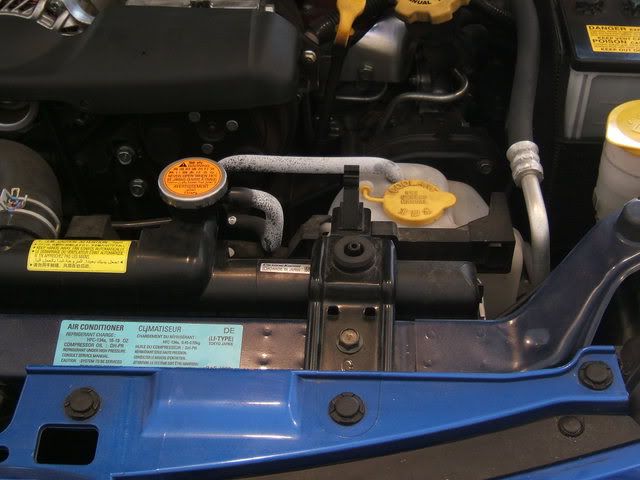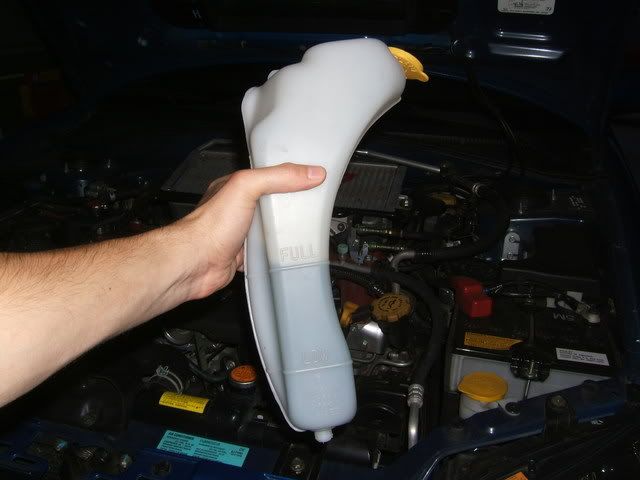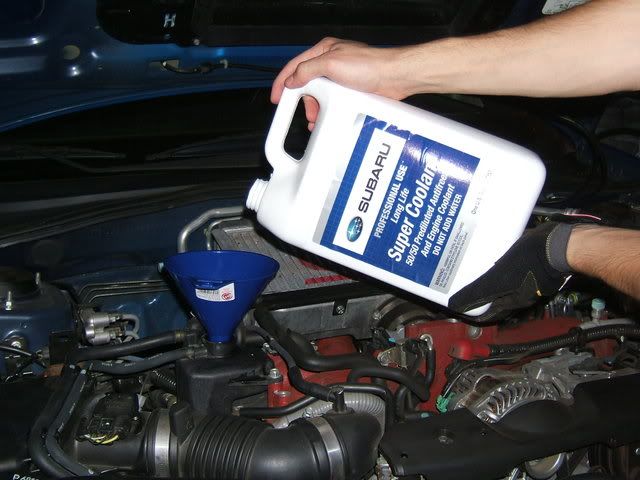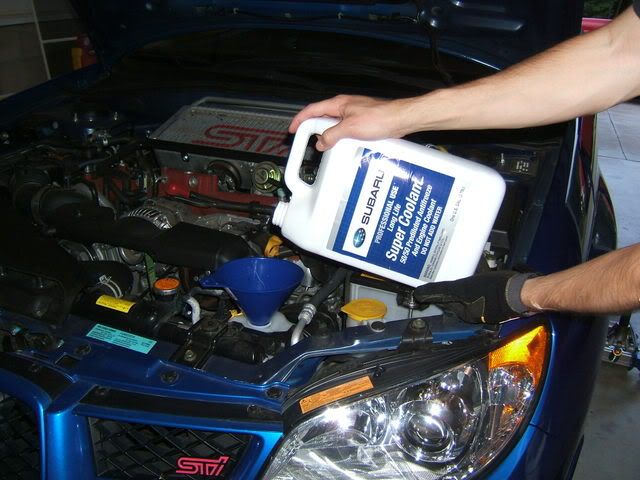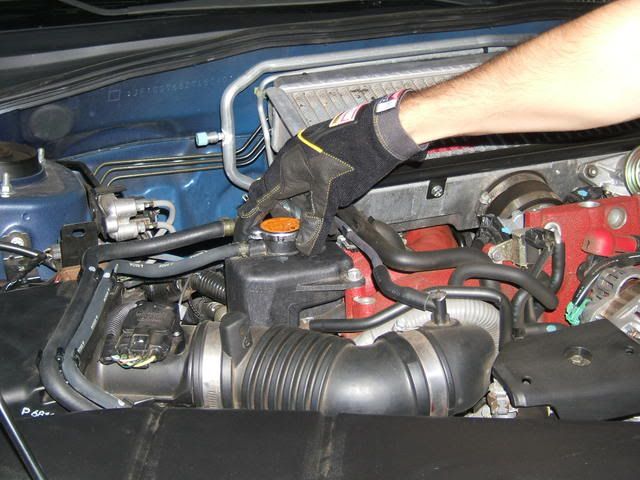Scope:
The following process is loosely based on the 07 STI Owner's Manual and is intended to help you replace your Engine Coolant as part of your 30K service. Special Note: For 2008+ models, you may have the newer blue Subaru coolant. This coolant has a change interval of 100K+ miles (see link). http://www.subaru.com/content/downloads/pdf/maintsched/2009SchedFed.pdf
Disclaimer:
When in doubt, have a qualified technician or maintenance shop perform your engine coolant change. The following procedure contains guidelines for changing your engine coolant and may not accurately reflect your particular car's coolant system. Read your Owner's Manual first when performing an Engine Coolant change. There is always a possibility that things will not go to plan. BoBoSTI contributed this youtube clip to the forum: 2005 STI Coolant Change - Lessons Learned - YouTube
Safety:
Engine Coolant or Radiator Fluid becomes hot when your car's engine operates. The radiator system becomes pressurized and can release hot fluid or vapor when a cap is removed. Be cautious and let your system cool down sufficiently before removing any caps and/or plugs. Your engine bay has many hot surfaces. Allow the components in your engine bay to cool off sufficiently before performing work to avoid getting burned. Wear proper safety glasses and clothing. If engine coolant spills on part of the exhaust, wipe it off as it has the potential to smoke and catch fire. There are fans located against your radiator tank that is used for cooling purposes. Don't allow any loose articles or clothing to get near the fans since they could become entangled. Last, of all, engine coolant is toxic. Do not allow any pets or young children near the vehicle when performing an engine coolant change. Once the coolant change is performed, monitor your vehicle for any leaks that appear in the engine bay or underneath the vehicle before and after the operation. The vehicle subframe and front undercover will catch most small leaks and they will evaporate without notice. If you have a strong coolant smell that does not go away in your engine bay or cabin (with the ventilation turned on), chances are that you have a leak in your system at a hose, cap, plug, gasket, or tank.
Disposal:
Antifreeze/Coolant is toxic and should be recycled, reused, or disposed of properly. If you are in luck, a local shop (or dealership) will allow you to pour your waste antifreeze/coolant into one of their bins. Automotive stores like Autozone or Advanced Auto do not typically have to recycle bins for antifreeze/coolant, although recently I've seen them start to. If you have difficulty locating a recycling facility, you will need to research Waste Management Utilities in your city/county. The first link below is to an EPA page that provides information on antifreeze/coolant recycling. The second link shows an example of a waste management facility.
1. Antifreeze | Municipal Solid Waste (MSW) | US EPA
2. City of Winston-Salem, NC:: Hazardous Waste Disposal
What to Wear:
Gloves
Long Sleeve Shirt
Safety Glasses
Tools:
Low profile jack (optional)
4 jack stands (optional)
Headlamp or flashlight
10mm Socket (optional for removing air intake scoop for additional access)
12mm Socket (for removing the Undercover)
19mm Socket (for removing the wheel lug nuts; optional)
Torque wrench (3/8" drive recommended)
Rags
Funnel
Wide drain container (8 Liter capacity)
Thin tipped flat head screwdriver
Small needle nose pliers (optional)
14,15, or 16mm socket with 1/8"-1/4" slot ground out of the end (optional)
Note: The socket in the picture was ground in a machine shop. It's only desired if you have trouble loosening the drain plug.
![Image]()
Materials:
Distilled Water (1 Gallon)
Subaru Genuine Engine Coolant Conditioner (1 x 125 mL bottle)
Subaru Genuine Engine Coolant (2 x 3.75 Liter bottles 50/50 Antifreeze/Water Solution) -or- (1 x 3.75 Liter bottles Undiluted Antifreeze Solution)
Note: There is a subtle difference between diluted and undiluted bottles so know what you are buying. Either will work, though. Just make sure you have the correct mixture of coolant and distilled water (50/50 recommended) before you pour it into the system. The 07 STI Coolant system holds approximately 7.7 liters (8.1 US quarts). Caution: The new premixed coolant is a blue color. The dealership and others on here have recently informed me that the old green coolant should not be mixed with the new blue coolant. However, this thread has evidence that states it is ok to mix them: Blue & Green Subaru Coolant The new coolant is supposedly rated for over 100,000 miles before it requires changing. If it is mixed with the older green coolant, the 30k service interval should be observed for changing the coolant. In either case, the coolant conditioner also needs to be added to the system. Here is a Subaru link dlkswinger posted on page 16 of this thread which specifies the replacement interval for 2008+ vehicles using the blue coolant: Subaru: Go Where the Love Takes You
![Image]()
![Image]()
Preparation:
Please note that having the car put up on jack stands and removing the wheels is optional. You can perform the whole coolant change from the top of the engine bay by removing the OEM air intake which gives you access to the drain plug underneath. The front undercover is also removable without putting the car up on jack stands. You'll need a low-profile drain container which is available at most supermarkets and auto shops. Optional steps are shown in the drain procedure section.
1. Park on a level surface and turn off the engine.
2. Secure the car from rolling by engaging the parking brake and putting the car in reverse after the engine is turned off. Use wheel chocks as necessary.
3. Loosen the front wheel lugnuts on the passenger side just enough that you can remove this wheel once the car is lifted up. I loosened them on the driver's side as well for the photo, but this is not necessary.
4. Put the car up level on all 4 jack stands. Reference the following link carefully as I do not condone all of the methods proposed here for securing the car: http://www.iwsti.com/forums/how-ins...ow-install/85671-how-complete-idiot-s-guide-getting-your-car-up-jackstands.html. The car should be placed on jack stands at the reinforced pinch welds whenever possible. It will not hurt to put additional support under the car in the unlikely event that the car's weight should shift or a jack stand or support member should fail. Whenever possible, do not place your body directly under the car when it is elevated on jack stands. It's also a good idea to have someone else nearby when working under a vehicle.
5. Remove the front wheel on the passenger side. Again, this is optional. I also removed the driver's side wheel for the photo, but this is not necessary.
6. Pop the engine hood and allow the engine to cool for at least an hour.
![Image]()
System Overview:
The "Drain Plug" sits at the bottom of the radiator on the passenger side. It sits directly over the subframe and is identified by its wingnut shape.
![Image]()
The "Filler Tank" is a small black plastic tank located over the engine between the air intake filter and the intercooler. It has a tabbed radiator cap. The Filler Tank is the highest point of the system.
The "Filler Neck" refers to the top portion of the Filler Tank just below the cap.
![Image]()
The "Radiator" is a large rectangular tank that sits vertically across the front of your engine bay. It has a round radiator cap. You do not need to remove the round cap at all during this process. However, it is an optional shortcut when you first fill the system during the filling procedure.
The "Reservoir Tank" is a white plastic tank that sits just to the right of the Radiator. It has a yellow plastic cap that reads "Coolant". For the 2007 STI, the part number is 45150FE000. The description is Tank Assy Reserve. This part includes the small coolant hose that runs from the radiator to the reservoir tank. The cost is approximately $52.44. I needed to replace mine due to a small leak at the base of the tank. The small coolant hose was also leaking due to a small tear in the hose.
![Image]()
The following process is loosely based on the 07 STI Owner's Manual and is intended to help you replace your Engine Coolant as part of your 30K service. Special Note: For 2008+ models, you may have the newer blue Subaru coolant. This coolant has a change interval of 100K+ miles (see link). http://www.subaru.com/content/downloads/pdf/maintsched/2009SchedFed.pdf
Disclaimer:
When in doubt, have a qualified technician or maintenance shop perform your engine coolant change. The following procedure contains guidelines for changing your engine coolant and may not accurately reflect your particular car's coolant system. Read your Owner's Manual first when performing an Engine Coolant change. There is always a possibility that things will not go to plan. BoBoSTI contributed this youtube clip to the forum: 2005 STI Coolant Change - Lessons Learned - YouTube
Safety:
Engine Coolant or Radiator Fluid becomes hot when your car's engine operates. The radiator system becomes pressurized and can release hot fluid or vapor when a cap is removed. Be cautious and let your system cool down sufficiently before removing any caps and/or plugs. Your engine bay has many hot surfaces. Allow the components in your engine bay to cool off sufficiently before performing work to avoid getting burned. Wear proper safety glasses and clothing. If engine coolant spills on part of the exhaust, wipe it off as it has the potential to smoke and catch fire. There are fans located against your radiator tank that is used for cooling purposes. Don't allow any loose articles or clothing to get near the fans since they could become entangled. Last, of all, engine coolant is toxic. Do not allow any pets or young children near the vehicle when performing an engine coolant change. Once the coolant change is performed, monitor your vehicle for any leaks that appear in the engine bay or underneath the vehicle before and after the operation. The vehicle subframe and front undercover will catch most small leaks and they will evaporate without notice. If you have a strong coolant smell that does not go away in your engine bay or cabin (with the ventilation turned on), chances are that you have a leak in your system at a hose, cap, plug, gasket, or tank.
Disposal:
Antifreeze/Coolant is toxic and should be recycled, reused, or disposed of properly. If you are in luck, a local shop (or dealership) will allow you to pour your waste antifreeze/coolant into one of their bins. Automotive stores like Autozone or Advanced Auto do not typically have to recycle bins for antifreeze/coolant, although recently I've seen them start to. If you have difficulty locating a recycling facility, you will need to research Waste Management Utilities in your city/county. The first link below is to an EPA page that provides information on antifreeze/coolant recycling. The second link shows an example of a waste management facility.
1. Antifreeze | Municipal Solid Waste (MSW) | US EPA
2. City of Winston-Salem, NC:: Hazardous Waste Disposal
What to Wear:
Gloves
Long Sleeve Shirt
Safety Glasses
Tools:
Low profile jack (optional)
4 jack stands (optional)
Headlamp or flashlight
10mm Socket (optional for removing air intake scoop for additional access)
12mm Socket (for removing the Undercover)
19mm Socket (for removing the wheel lug nuts; optional)
Torque wrench (3/8" drive recommended)
Rags
Funnel
Wide drain container (8 Liter capacity)
Thin tipped flat head screwdriver
Small needle nose pliers (optional)
14,15, or 16mm socket with 1/8"-1/4" slot ground out of the end (optional)
Note: The socket in the picture was ground in a machine shop. It's only desired if you have trouble loosening the drain plug.

Materials:
Distilled Water (1 Gallon)
Subaru Genuine Engine Coolant Conditioner (1 x 125 mL bottle)
Subaru Genuine Engine Coolant (2 x 3.75 Liter bottles 50/50 Antifreeze/Water Solution) -or- (1 x 3.75 Liter bottles Undiluted Antifreeze Solution)
Note: There is a subtle difference between diluted and undiluted bottles so know what you are buying. Either will work, though. Just make sure you have the correct mixture of coolant and distilled water (50/50 recommended) before you pour it into the system. The 07 STI Coolant system holds approximately 7.7 liters (8.1 US quarts). Caution: The new premixed coolant is a blue color. The dealership and others on here have recently informed me that the old green coolant should not be mixed with the new blue coolant. However, this thread has evidence that states it is ok to mix them: Blue & Green Subaru Coolant The new coolant is supposedly rated for over 100,000 miles before it requires changing. If it is mixed with the older green coolant, the 30k service interval should be observed for changing the coolant. In either case, the coolant conditioner also needs to be added to the system. Here is a Subaru link dlkswinger posted on page 16 of this thread which specifies the replacement interval for 2008+ vehicles using the blue coolant: Subaru: Go Where the Love Takes You


Preparation:
Please note that having the car put up on jack stands and removing the wheels is optional. You can perform the whole coolant change from the top of the engine bay by removing the OEM air intake which gives you access to the drain plug underneath. The front undercover is also removable without putting the car up on jack stands. You'll need a low-profile drain container which is available at most supermarkets and auto shops. Optional steps are shown in the drain procedure section.
1. Park on a level surface and turn off the engine.
2. Secure the car from rolling by engaging the parking brake and putting the car in reverse after the engine is turned off. Use wheel chocks as necessary.
3. Loosen the front wheel lugnuts on the passenger side just enough that you can remove this wheel once the car is lifted up. I loosened them on the driver's side as well for the photo, but this is not necessary.
4. Put the car up level on all 4 jack stands. Reference the following link carefully as I do not condone all of the methods proposed here for securing the car: http://www.iwsti.com/forums/how-ins...ow-install/85671-how-complete-idiot-s-guide-getting-your-car-up-jackstands.html. The car should be placed on jack stands at the reinforced pinch welds whenever possible. It will not hurt to put additional support under the car in the unlikely event that the car's weight should shift or a jack stand or support member should fail. Whenever possible, do not place your body directly under the car when it is elevated on jack stands. It's also a good idea to have someone else nearby when working under a vehicle.
5. Remove the front wheel on the passenger side. Again, this is optional. I also removed the driver's side wheel for the photo, but this is not necessary.
6. Pop the engine hood and allow the engine to cool for at least an hour.
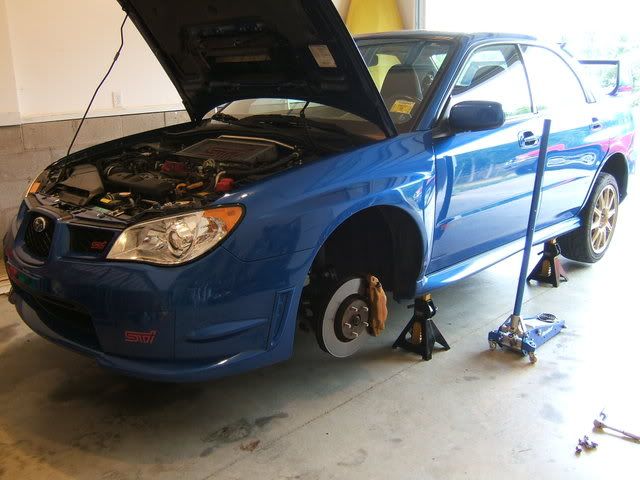
System Overview:
The "Drain Plug" sits at the bottom of the radiator on the passenger side. It sits directly over the subframe and is identified by its wingnut shape.

The "Filler Tank" is a small black plastic tank located over the engine between the air intake filter and the intercooler. It has a tabbed radiator cap. The Filler Tank is the highest point of the system.
The "Filler Neck" refers to the top portion of the Filler Tank just below the cap.
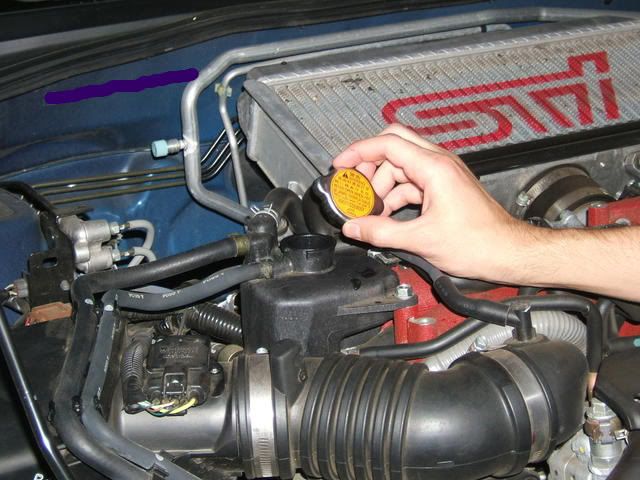
The "Radiator" is a large rectangular tank that sits vertically across the front of your engine bay. It has a round radiator cap. You do not need to remove the round cap at all during this process. However, it is an optional shortcut when you first fill the system during the filling procedure.
The "Reservoir Tank" is a white plastic tank that sits just to the right of the Radiator. It has a yellow plastic cap that reads "Coolant". For the 2007 STI, the part number is 45150FE000. The description is Tank Assy Reserve. This part includes the small coolant hose that runs from the radiator to the reservoir tank. The cost is approximately $52.44. I needed to replace mine due to a small leak at the base of the tank. The small coolant hose was also leaking due to a small tear in the hose.
